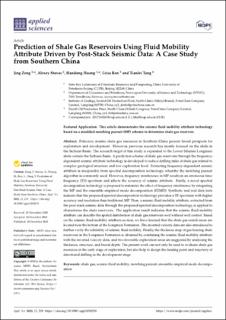| dc.contributor.author | Zeng, Jing | |
| dc.contributor.author | Stovas, Alexey | |
| dc.contributor.author | Huang, H. | |
| dc.contributor.author | Ren, Lei | |
| dc.contributor.author | Tang, Tao | |
| dc.date.accessioned | 2022-10-13T09:33:23Z | |
| dc.date.available | 2022-10-13T09:33:23Z | |
| dc.date.created | 2021-10-27T14:49:11Z | |
| dc.date.issued | 2021 | |
| dc.identifier.citation | Applied Sciences. 2021, 11 (219), 1-18. | en_US |
| dc.identifier.issn | 2076-3417 | |
| dc.identifier.uri | https://hdl.handle.net/11250/3025833 | |
| dc.description.abstract | Paleozoic marine shale gas resources in Southern China present broad prospects for exploration and development. However, previous research has mostly focused on the shale in the Sichuan Basin. The research target of this study is expanded to the Lower Silurian Longmaxi shale outside the Sichuan Basin. A prediction scheme of shale gas reservoirs through the frequency-dependent seismic attribute technology is developed to reduce drilling risks of shale gas related to complex geological structure and low exploration level. Extracting frequency-dependent seismic attribute is inseparable from spectral decomposition technology, whereby the matching pursuit algorithm is commonly used. However, frequency interference in MP results in an erroneous time-frequency (TF) spectrum and affects the accuracy of seismic attribute. Firstly, a novel spectral decomposition technology is proposed to minimize the effect of frequency interference by integrating the MP and the ensemble empirical mode decomposition (EEMD). Synthetic and real data tests indicate that the proposed spectral decomposition technology provides a TF spectrum with higher accuracy and resolution than traditional MP. Then, a seismic fluid mobility attribute, extracted from the post-stack seismic data through the proposed spectral decomposition technology, is applied to characterize the shale reservoirs. The application result indicates that the seismic fluid mobility attribute can describe the spatial distribution of shale gas reservoirs well without well control. Based on the seismic fluid mobility attribute section, we have learned that the shale gas enrich areas are located near the bottom of the Longmaxi Formation. The inverted velocity data are also introduced to further verify the reliability of seismic fluid mobility. Finally, the thickness map of gas-bearing shale reservoirs in the Longmaxi Formation is obtained by combining the seismic fluid mobility attribute with the inverted velocity data, and two favorable exploration areas are suggested by analyzing the thickness, structure, and burial depth. The present work can not only be used to evaluate shale gas resources in the early stage of exploration, but also help to design the landing point and trajectory of directional drilling in the development stage. | en_US |
| dc.language.iso | eng | en_US |
| dc.publisher | MDPI | en_US |
| dc.rights | Navngivelse 4.0 Internasjonal | * |
| dc.rights.uri | http://creativecommons.org/licenses/by/4.0/deed.no | * |
| dc.title | Prediction of shale gas reservoirs using fluid mobility attribute driven by post-stack seismic data: A case study from Southern China | en_US |
| dc.title.alternative | Prediction of shale gas reservoirs using fluid mobility attribute driven by post-stack seismic data: A case study from Southern China | en_US |
| dc.type | Peer reviewed | en_US |
| dc.type | Journal article | en_US |
| dc.description.version | publishedVersion | en_US |
| dc.source.pagenumber | 1-18 | en_US |
| dc.source.volume | 11 | en_US |
| dc.source.journal | Applied Sciences | en_US |
| dc.source.issue | 219 | en_US |
| dc.identifier.doi | 10.3390/app11010219 | |
| dc.identifier.cristin | 1948956 | |
| dc.relation.project | Norges forskningsråd: 294404 | en_US |
| dc.relation.project | Norges forskningsråd: 309960 | en_US |
| cristin.ispublished | true | |
| cristin.fulltext | original | |
| cristin.qualitycode | 1 | |

